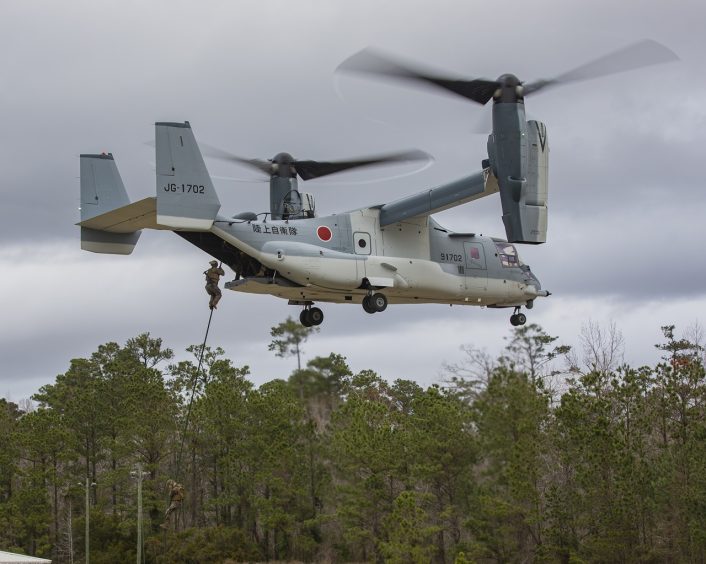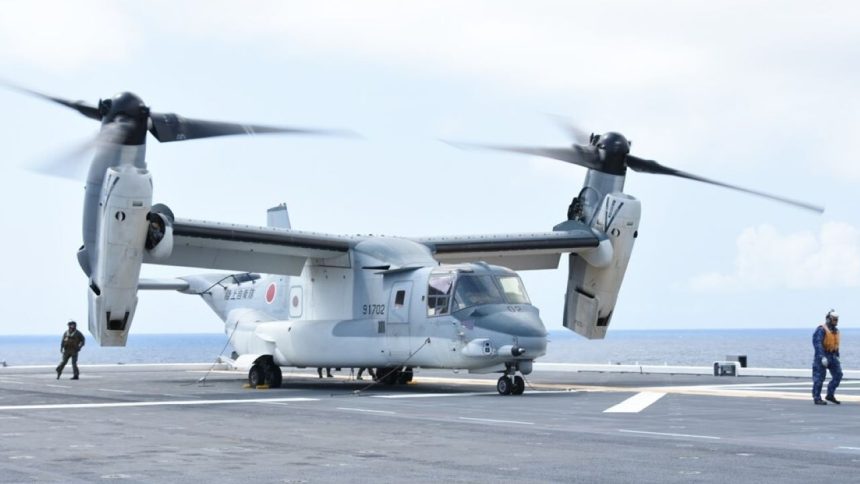In early September, the 107th Squadron conducted takeoff and landing training with the V-22 on the JMSDF destroyer Izumo, while the sister ship JS Kaga will soon start trials with the F-35B.
The Japan Ground Self-Defense Force (JGSDF), the only foreign operator of the V-22 Osprey, announced on Sep. 22, 2024, that it conducted take-off and landing training on the JS Izumo carrier of the Japan Maritime Self-Defense Force (JMSDF) early this month. This comes nearly two months after the U.S. Air Force’s CV-22 Ospreys resumed operations in Japan, following the crash of an aircraft off the coast of Japan on Nov. 29, 2023, that killed eight personnel.
The crash led to a three-month safety stand down of all Ospreys and the American and Japanese militaries later announced a synergized “phased” and “gradual” resumption of flights, synchronized “training” and new maintenance and piloting procedures. The investigation found that the accident was caused by a “catastrophic failure” of the left-hand proprotor gearbox (PRGB).
It is not clear how many V-22s landed on the Izumo, but only one unit can be made out from the released pictures, with the serial number ‘91702’. Going by the announcement, the training may have taken place in the first week of September.
こんにちは!輸送航空隊です😁9月上旬、第107飛行隊は、#海上自衛隊 の護衛艦「いずも」での発着艦訓練を行いました。今回は、護衛艦への離着陸に併せて、護衛艦からの燃料補給を行いました!!海自隊員、操縦士及び機上整備員は、艦上作業等に係る緊密な連携強化を図りました😊 #V22 #オスプレイ pic.twitter.com/suEjYUCojn
— 第1ヘリコプター団/木更津駐屯地 (@1st_helb) September 21, 2024
The JGSDF appears to have now received all the 17 units of the planned fleet of V-22 Ospreys, after the Kisarazu Garrison announced on Jul. 12 the “delivery completion ceremony” of the remaining aircraft. The fist two Ospreys arrived on May 8, 2020 at Marine Corps Air Station Iwakuni, while a second load of four units were delivered to the same location on Feb. 14, 2021.
JGSDF’s Ospreys on ships
The 1st Helicopter Wing, located at the Kisarazu Garrison, said while sharing the pictures of the training event on X: “In early September, the 107th Squadron conducted takeoff and landing training on the JMSDF destroyer Izumo. This time, in addition to taking off and landing on the destroyer, we also refueled from the destroyer! The JMSDF personnel, pilots, and on-board maintenance staff strengthened close cooperation regarding on-board work, etc.”
It is not clear if JGSDF’s or American Ospreys have landed on the Izumo before, but it appears to be the first time. In 2020, however, U.S. Air Force CV-22s landed in the Izumo’ sister ship, the JS Kaga. The first time ever an Osprey landed on a Japanese ship was in 2013, when an U.S. Marine Corps MV-22 landed on the JS Hyuga off the coast of California.
The first landing of a Japanese Osprey on a Japanese ship happened ten years later. In fact, on Sep. 5, 2023, a JGSDF Osprey landed on a JMSDF helicopter carrier, the Hyuga-class JS Ise. The goal was to improve the joint operational capabilities of the JMSDF and JGSDF as they continue to work together on the Amphibious Rapid Deployment Brigade (ARDB).
On September 5, JS ISE conducted a takeoff/landing drill around Ogasawara Islands with V-22 Osprey belonging to Japan Ground Self-Defense Force 1stHelicopter Brigade. Through the drill, the unit improved JMSDF-JGSDF cooperative operational capabilities. #FreeandOpenIndoPacific pic.twitter.com/Ipnv742UhV
— JMSDF Self-Defense Fleet ENG (@JMSDF_SDF_ENG) September 6, 2023
Ospreys resuming full operations?
The V-22’s landing on the JS Izumo can be assumed to have taken place much before the head of the U.S. Air Force Special Operations Command (AFSOC), Lt. Gen. Michael E. Conley, announced on Sep. 18, 2024, that he would deploy a number of CV-22 Ospreys on operations abroad for the first time since Nov. 2023’s fatal crash in Japan.
Around the same time the statement was made, an MV-22 of the U.S. Marine Corps experienced an engine fire on the ground at Fairchild Air Force Base in Washington, but no casualties or injuries were reported. It would be important to mention that one of the “restricted” flight envelopes stipulated for the Ospreys earlier this year was for the aircraft to fly for not more than 30 minutes away from suitable airfields in order to quickly return in case of emergencies.
Mirroring! A V-22 Osprey from JGSDF’s 1st Helicopter Brigade at JGSDF Camp Kasumigaura in Kasumigaura, Ibaraki. Japan is the only other country in the world, besides the United States, to operate the type. #avgeeks #aviation #aviationdaily #Japan pic.twitter.com/5ABnXslOR0
— Air Power (@RealAirPower1) August 30, 2023
Prior to that, on Jul. 2, the 374th Airlift Wing at Yokota Air Base announced that the 353rd Special Operations Wing resumed CV-22 operations. This was following a “meticulous and data-driven approach” and amid “maintenance and procedural mitigation controls.”
On Aug. 15, 2024, a U.S. Marine Corps MV-22B from the Marine Tiltrotor Squadron 365 (VMM 365) landed on the Turkish navy’s TCG Anadolu amphibious assault carrier, possibly for the first time, while the two navies were undertaking bilateral exercises.
The tiltrotor also figured in several multilateral maneuvers between participating countries during this year’s Rim of the Pacific (RIMPAC) exercise. It therefore does appear that the aircraft is being flown regularly following the mishaps, but possibly under more vigilant safety procedures such as the new emergency checklists mentioned by Lt. Gen. Conley.

Izumo and Kaga also Preparing for F-35B STOVL Jet
Both the JS Izumo and the JS Kaga were announced to be put through modifications to their flight deck to become able to operate F-35B Lightning II STOVL (Short Take-Off Vertical-Lanning) aircraft and be employed as “Lightning Carriers.” The Izumo underwent the first phase of modifications in 2021, which consisted of coating its flight deck with heat-resistant paint, and later saw the first landing of a F-35B in cooperation with the U.S. Marine Corps.
The second stage of reconstruction is expected to commence by late this year or early-2025 to meet its Fiscal Year 2024 target date. This phase will see the trapezoidal flight deck changed to a rectangular one, beside setting up internal compartments and infrastructure to support F-35B operations, the vital one being magazines storing the jet’s munitions and ordnance.
Meanwhile, the refit of the JS Kaga started in March 2022 at the Kure shipyard located in Hiroshima and the JMSDF released its images following the reconstruction on Apr. 6, 2024. It sported the new rectangular flight deck and is preparing to host Japan’s F-35Bs soon, as the first batch six from an order of 42 is scheduled to be delivered by late this year.
横須賀本港で「いずも」入港を迎えてきました⚓️#いずも型護衛艦 (Izumo-class)
🇯🇵【#いずも (JS Izumo DDH-183)】2024/05/22📸 pic.twitter.com/W0DZU5Htox
— ⚓妖の類📷 (@AyakashiKamo) May 22, 2024
On Sep. 18, reports said the JMSDF announced that it planned to conduct “ship-based developmental trials” for the F-35B from Oct. 5 to Nov. 18, in the waters off San Diego on the U.S.’s western seaboard. This was preceded by JMSDF officials visiting the Italian Navy’s ITS Cavour aircraft carrier late in August to study F-35B operations, when Rome sent the warship to the Yokosuka Naval Base during its Indo-Pacific campaign which led to the Initial Operational Capability of the Italian F-35B fleet.
According to Defense News, last year Japanese military officials also visited the HMS Prince of Wales carrier to watch Royal Navy F-35B operations. These visits are important as Japan is working for the first time on a STOVL carrier capability, while Italy and the U.K. have decades of experience which they can share, in addition to being the other current F-35B operators outside the United States.
Regarding the sea trials, it is expected they will be similar to what was done with the ITS Cavour, the HMS Queen Elizabeth and the HMS Prince of Wales. In those occasions, the F-35 Patuxent River Integrated Test Force deployed two specially instrumented F-35Bs of Air Test and Evaluation Squadron (VX) 23, with the trials lasting around four weeks.
In the case of the ITS Cavour, as part of the sea trials, the two F-35Bs of VX-23 carried out more than 50 flight missions, in all weather and sea state conditions, a night session, around 120 vertical landings, and as many short take-offs with the aid of the ski jump, and finally a vertical take-off test. Some tests were also conducted with external loads.









